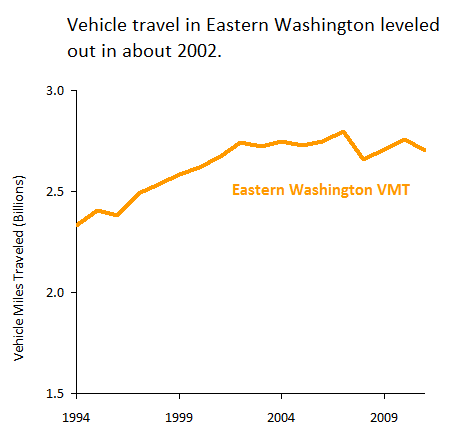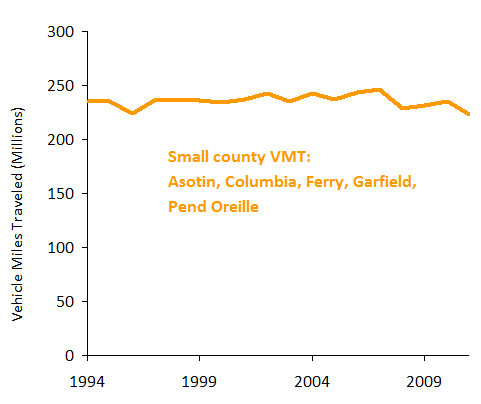I’ve been following flat-lining traffic trends for a while now—and much of my focus has been in Cascadia’s big cities and major metro areas. But the trends are equally clear in smaller cities and rural areas.
Take, for example, this chart of traffic in Eastern Washington, with the latest data from WSDOT’s Annual Traffic Report:
 As you can see, traffic volumes in the eastern third of Washington rose fairly steadily through about 2002. Since then, they’ve been stuck on a bumpy plateau.
As you can see, traffic volumes in the eastern third of Washington rose fairly steadily through about 2002. Since then, they’ve been stuck on a bumpy plateau.
About 45 percent of the traffic in the chart above came from Spokane County, which is dominated by a mid-sized city and its suburbs. But what about the smaller counties? Is their traffic on the upswing?
To find out, I took a look at the five smallest counties in Eastern Washington, ranked by population. As a caveat: because the sample is pretty small, I don’t know how much stock to put in the numbers—but it’s an even more surprising trend than for the region as a whole:
Yep, that’s right: according to WSDOT, small counties in Eastern Washington have seen no net traffic growth since 1994. Yes, there have been temporary blips up and down, and vehicle travel may have dipped a bit since 2008. But the basic trend is flat. And in case you’re wondering, these counties have actually been growing: the census says that population in those five counties grew by about 12 percent over the period covered in that chart.
Clearly, the flat-lining of traffic isn’t just affecting big cities; it’s not simply a result of big urban highways filling up to capacity. Instead, the trends are much more widespread. It’s good news in some very important ways…but it’s also news that doesn’t seem to have filtered down into the official thinking about big highway expansions.


Comments are closed.